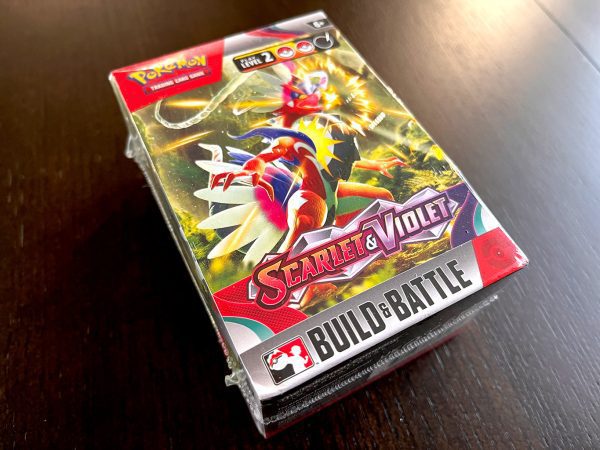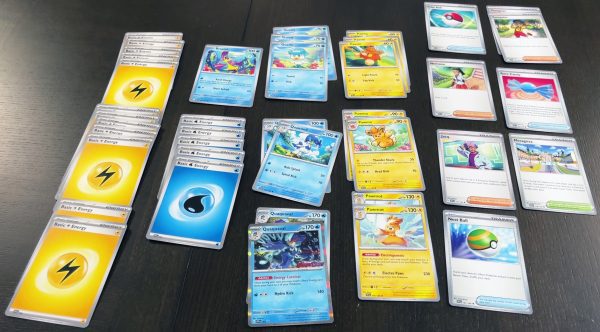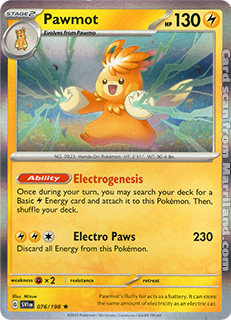There are a lot of ways to get started with the Pokémon TCG, but one particularly fun way to get started while also getting a preview of a new set is by picking up a Build & Battle box. My friends at The Pokémon Company International were kind enough to send me a Build & Battle box to check out for review, so this will hopefully give you an idea of what to expect from it.
In the case of the Scarlet & Violet Build & Battle boxes, these became available on March 17, 2023, which is two weeks before the official launch of the Scarlet & Violet TCG set on March 31, 2023. This tends to be the case with other Build & Battle boxes, where they are available as an early preview (or in Prerelease tournaments) two weeks before the launch of that set, giving players a chance to check out the new cards early, and hopefully having a chance to battle some other players looking to do the same.
Even though the Build & Battle boxes are ideal for before a set is released, they can also be pretty fun to pick a few up after the set is released and play with some friends or family—of course, if you go that route, you may also want to consider a house rule of not applying Weakness or Resistance just to keep things fair. 😉 This applies with any Build & Battle box, too, not just the Scarlet & Violet one!
What is a Build & Battle Box?
If you’ve ever played in older Prerelease tournaments or events, it’s kind of like that, and modern Prerelease events use these as well. Essentially, you buy the Build & Battle box (or entry to the Prerelease tournament) and it contains a preconstructed 40-card deck along with 4 booster packs of the set.
You can then modify your preconstructed 40-card deck using the cards you pull from your 4 booster packs, and then you battle other players with it (or friends if you just buy the Build & Battle boxes separately). At Prerelease events, basic Energy cards are usually provided as well, in case you want to build a deck using different types than what you get in the preconstructed deck.
Because decks use just 40 cards instead of the usual 60, players set down just 4 Prize cards instead of 6 for any matches played using these Build & Battle decks.
Promo Cards
The Build & Battle preconstructed decks each contain one of four Promo cards. These are alternate art versions of cards in the set. In the case of the Scarlet & Violet Build & Battle kit, you can get either Quaquaval (SV005), Pawmot (SV006), Hawlucha (SV007), or Revavroom (SV008). The one you get is random, but it corresponds to the contents of your preconstructed deck.
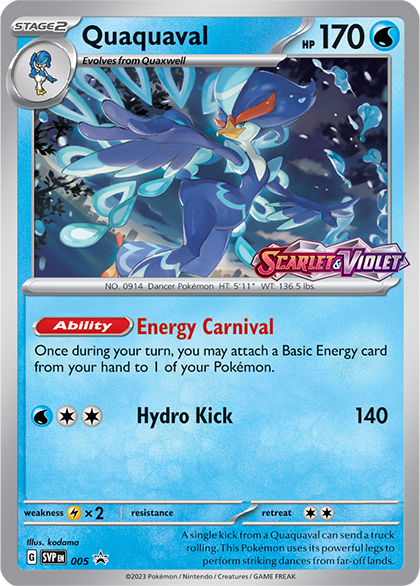


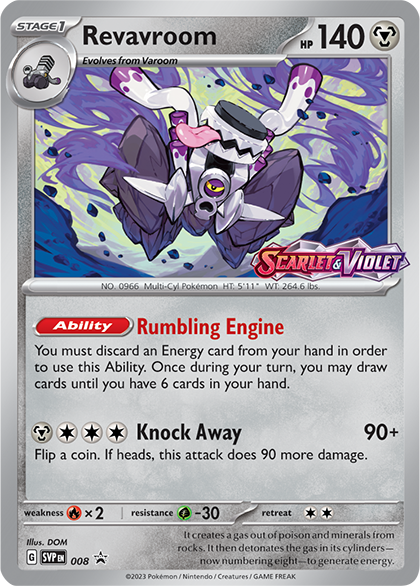
In my case, I got the Quaquaval (SV005) card, since my random preconstructed deck was the Quaquaval + Pawmot version. My Build & Battle deck contained non-holo versions of Quaquaval and Pawmot from the Scarlet & Violet set, which are normally only available in holographic versions—this is the case for any normally holo-rare cards that would be included in the Build & Battle preconstructed deck.
My Quaquaval + Pawmot Preconstructed Deck
While your contents may vary, I ended up getting the Quaquaval + Pawmot preconstructed deck, which is based around using Quaquaval to attach extra Basic Energy cards from your hand, and then Pawmot to do massive damage while also searching your deck for Lightning Energy to power it up.
Here’s a complete deck list, along with links to the individual cards, if you’d like a better look:
Pokémon
As mentioned earlier, the strategy for this particular preconstructed deck is to use Pawmot to search your deck for Lightning Energy and attach it to itself with its Electrogenesis Ability, and then deal a massive 230 damage with its Electro Paws attack, although that discards all of its Energy.
Quaquaval can attach extra Energy cards from your hand with its Energy Carnival Ability, so this can help power up either Pawmot or Quaquaval. Quaquaval’s attack is straightforward, but powerful, dealing a solid 140 damage for three Energy—two Colorless and one Water. This relatively shallow Water Energy cost is why the deck is primarily Lightning, because Pawmot needs a lot more of it.
Bruxish is there to search for extra Basic Energy cards and add them to your hand, although since it requires a Water Energy in order to use its Vivid Charge attack, I would not think this to be consistent enough to depend on early-game using only the 5 Water Energy in the deck, and I ultimately replaced it after opening up my booster packs. Alternatively, swapping to 6 Water/11 Lightning could have probably made it a bit more consistent.
As for Trainers, it was a bit light on Trainer cards, with just four Supporter cards total. Since it’s just a 40 card deck, you don’t want to draw cards too fast, but it’s still important to be able to draw cards. Poké Ball, Nest Ball, Jacq, and Mesagoza help you get your Pokémon into play, while Rare Candy is helpful for skipping the Stage 1 Evolution for your Quaquaval or Pawmot line. Adding more Rare Candy would be nice in a preconstructed deck like this.
What I Pulled From My Packs
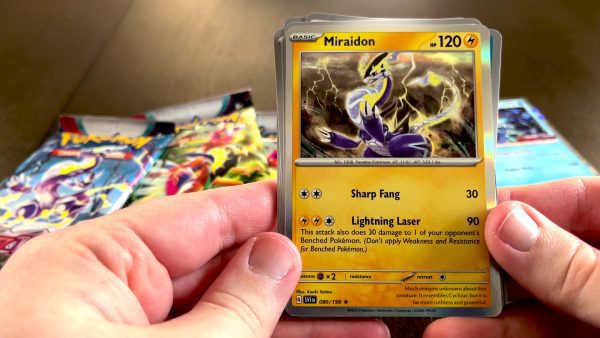
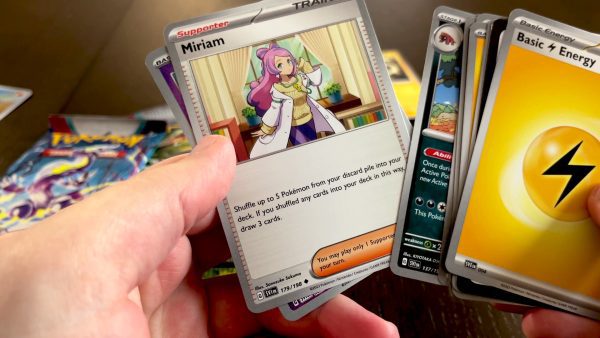
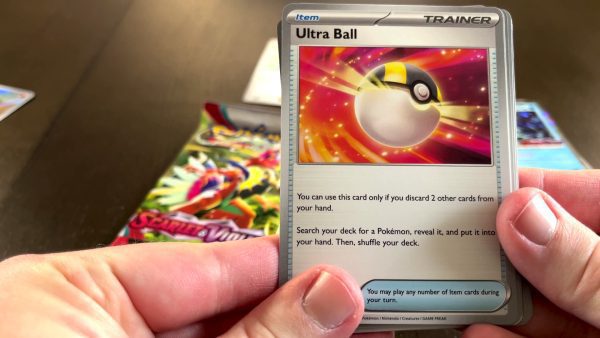
I pulled a few cool cards from my four booster packs, although trying to decide what would be a good fit for my deck was a bit of a challenge. One of the best cards that I pulled that was an easy fit was Miraidon, a holo-rare Basic Pokémon that requires Lightning Energy and hits pretty hard. Starting with this would be fantastic as it can do good damage and it doesn’t even need Lightning Energy for its first attack. Its second attack, Lightning Laser, hits the opponent’s Active Pokémon for 90 damage and then one of their Benched Pokémon for 30.
Miriam was a noteworthy Supporter card that could help bring back discarded Pokémon cards and also help me draw cards if I do so. It’s not useful on the first turn, before I have any Pokémon in my discard pile, but it’s particularly nice after that. Having a way to get cards back from your discard pile is important; unfortunately, I didn’t pull anything useful for bringing back Energy cards, which is a bit rough since Pawmot discards a lot of Energy. Something like an Energy Retrieval would have been a fantastic addition.
Ultra Ball was another helpful pull, allowing me to discard two cards from my hand to search my deck for any Pokémon, including evolved Pokémon, which is great to get those Stage 1s or Stage 2s I need for evolving. It also synergized well with Miriam, to put any discard Pokémon I wouldn’t need at that moment back into my deck if needed. Ultra Ball is overall a great card, though, and I did swap out the ordinary Poké Ball for that.
Final Changes to My Preconstructed Deck
After opening up my four booster packs and taking a careful look at what I pulled, I decided on making the following changes to my preconstructed deck:
Removed
- -2 Lightning Energy
- -1 Poké Ball
- -1 Mesagoza
Added
- +1 Miraidon
- +1 Jacq
- +1 Miriam
- +1 Ultra Ball
Although Mesagoza is very nice for getting Evolution Pokémon from your deck, it’s a coin flip, and your opponent can also use its effect; since the deck added an extra Jacq and an Ultra Ball, it should be more consistent at getting those Evolution Pokémon even without Mesagoza.
Two Lightning Energy being removed brings the total count down to 10 Lightning and 5 Water, which is a little light, but it was between removing an Energy or removing Bruxish, and ultimately I chose Bruxish. This allowed me to add the Miriam and the Miraidon. Miraidon definitely needed to go into the deck—there was no question about that.
Conclusion
Because I got this Build & Battle box quite early for review purposes, I didn’t have anyone to actually play against, so a lot of these thoughts are just theorizing. That’s fine, that’s still pretty fun, and it definitely takes me back to the days when I played in Prerelease events!
This is my first time in a long time opening up a Build & Battle box—the last time I opened something like this, it was still called a Prerelease box or kit or something like that. Back in the day, you used to have to build a deck using only six booster packs given to you at Prerelease events, which meant sometimes you could have amazing pulls and other times you could have barely anything workable—it was all luck of the draw.
By having the preconstructed “decks” as a foundation and using just four packs to upgrade it with, it meant there was a lot less risk of being without usable Trainers or Pokémon, but at the same time I personally feel it took away a lot of the uniqueness in Prerelease decks, since a lot of people would wind up with more or less the same style.
Hopefully this gives you an idea of what to expect from not just the Scarlet & Violet Build & Battle box, but Build & Battle boxes in general, and if you have a local hobby shop or card shop, you should see if they have a Prerelease event available or Build & Battle boxes for sale if it sounds like something you’d like to try out. You can also find Prerelease events in your area by using Pokémon’s store locator and inputting your location.
DISCLAIMER: The product covered in this review was provided by The Pokémon Company International free of charge. No monetary or financial compensation was exchanged for this review by either party, and all thoughts and opinions are independent.

